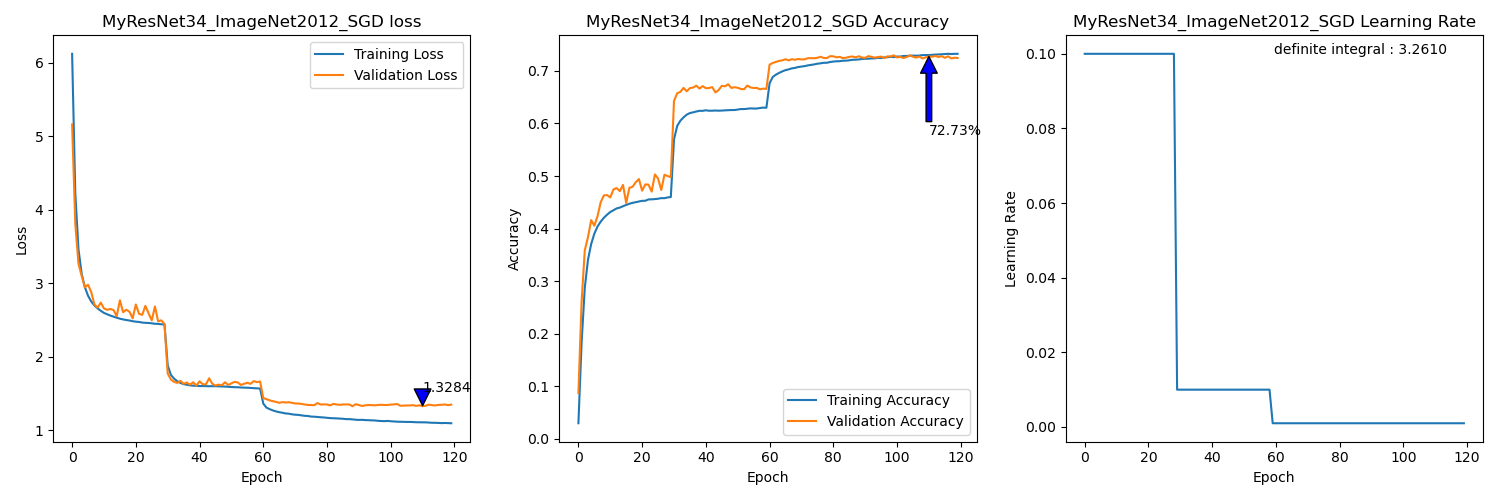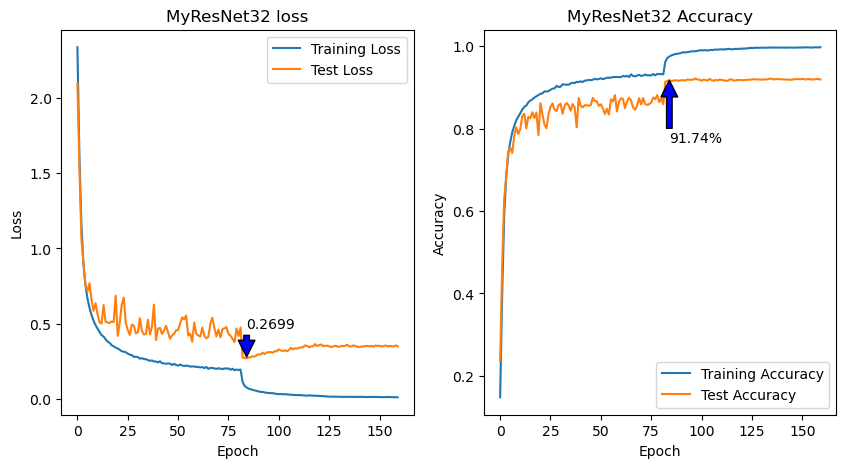Dept. of Embedded Systems Engineering, Incheon National University
- The purpose of this project is that to create a ResNet using Pytorch and to get the accuracy of near original paper's one!
- The Origin ResNet32 have 7.51% top-1 error rate in CIFAR-10 dataset.
- The Origin ResNet34 have 21.53% top-1 error rate in ImageNet2012 dataset.
Haven't achieved that yet.
Ubuntu 22.04 LTSPython 3.11.5Pytorch 2.2.0CUDA 12.1pip [copy, time, tqdm, matplotlib, etc..]- I used
i7-9700k, DDR4 64GB, GTX3090
- We initialize the weights as on He initialization
- We adopt batch normalization after each convolutional and before activation
- We use SGD with a mini-batch size of 256
- The learning rate starts from 0.1 and is divided by 10 when the error plateaus
- We use a weight decay of 0.0001 and a momentum of 0.9
- We do not use dropout
- The image is resized with its shorter side randomly sampled in [256, 480] for scale augmentation [41].
- A 224×224 crop is randomly sampled from an image or its horizontal flip, with the per-pixel mean subtracted [21].
- The standard color augmentation in [21] is used.
So, Apply
PCA_Color_Augmentation - In testing, for comparison studies we adopt the standard 10-crop testing [21]. For best results, we adopt the fully- convolutional form as in [41, 13], and average the scores at multiple scales (images are resized such that the shorter side is in {224, 256, 384, 480, 640}).
Implemented on
src/Prediction_for_MultiScaleTest.ipynb
- 45k/5k train/valid split from origin train set(50k)
- 4 pixels are padded on each side, and a 32 x 32 crop is randomly sampled from the padded image or its horizontal flip.
- For testing, use original images
model = MyResNet_CIFAR(num_classes=10, num_layer_factor = 5, Downsample_option="A").to("cuda")
criterion = nn.CrossEntropyLoss()
optimizer = optim.SGD(model.parameters(), lr=0.1, momentum=0.9, weight_decay=1e-4)
scheduler = optim.lr_scheduler.MultiStepLR(optimizer, milestones=[82, 123], gamma=0.1)
earlystopper = EarlyStopper(patience=999, model=model, file_name=file_name)epochs = 180batch = 128
train.transforms = Compose([
Compose([ToImage(), ToDtype(scale=True)])
RandomCrop(32, padding=4),
RandomHorizontalFlip(),
Normalize(mean=[0.485, 0.456, 0.406], std=[0.229, 0.224, 0.225]),
])
test.transforms = Compose([
Compose([ToImage(), ToDtype(scale=True)])
Normalize(mean=[0.485, 0.456, 0.406], std=[0.229, 0.224, 0.225]),
]) model = MyResNet34(num_classes=1000, Downsample_option="B").to("cuda")
criterion = nn.CrossEntropyLoss()
optimizer = optim.SGD(model.parameters(), lr=0.1, momentum=0.9, weight_decay=1e-4)
scheduler = optim.lr_scheduler.MultiStepLR(optimizer, milestones=[30, 60], gamma=0.1)
file_name = "MyResNet34_ImageNet2012_rezero"
earlystopper = EarlyStopper(patience=999, model=model, file_name=file_name)epochs = 120batch = 256
# PCAColorAugmentation
class PCAColorAugmentation(object):
"""
ResNet paper's say; The standard color augmentation in [21] is used.
- [21] : AlexNet paper.
- PCA Color Augmentation
1. Get the eigenvalue and eigenvector of the covariance matrix of the image pixels. (ImageNet2012)
2. [r, g, b] = [r, g, b] + [p1, p2, p3] matmul [a1 * r1, a2 * r2, a3 * r3].T
"""
def __init__(self):
self._eigval = torch.tensor([55.46, 4.794, 1.148]).reshape(1, 3)
self._eigvec = torch.tensor(
[
[-0.5675, 0.7192, 0.4009],
[-0.5808, -0.0045, -0.8140],
[-0.5836, -0.6948, 0.4203],
]
)
def __call__(self, _tensor: torch.Tensor):
"""
Input : torch.Tensor [C, H, W]
Output : torch.Tensor [C, H, W]
"""
return _tensor + torch.matmul(
self._eigvec,
torch.mul(self._eigval, torch.normal(mean=0.0, std=0.1, size=[1, 3])).T,
).reshape(3, 1, 1)
# Training set
train = Compose(
RandomShortestSize(min_size=range(256, 480), antialias=True),
RandomCrop(size=224),
Compose([ToImage(), ToDtype(torch.float32, scale=True)]),
Normalize(
mean=[0.485, 0.456, 0.406], std=[0.229, 0.224, 0.225], inplace=True
),
PCAColorAugmentation(),
RandomHorizontalFlip(),
)
# center croped valid set
valid = Compose(
RandomShortestSize(min_size=range(256, 480), antialias=True),
# VGG에서 single scale로 했을 때는 두 range의 median 값으로 crop함.
CenterCrop(size=368),
Compose([ToImage(), ToDtype(torch.float32, scale=True)]),
Normalize(
mean=[0.485, 0.456, 0.406], std=[0.229, 0.224, 0.225], inplace=True
),
)-
Training & Center Crop Validation
-


- Figure 4. Training on ImageNet. Thin curves denote training error, and bold curves denote validation error of the center crops. Right: ResNets of 18 and 34 layers. In this plot, the residual networks have no extra parameter compared to their plain counterparts.
- 빨간 실선 (Center Crop valid)의 최저 수치는 약 25%가량으로, MyResNet34의 최저 error 27.27%과 비슷함.
-
-
10-Crop Testing
# 10-croped valid set scales = [224, 256, 384, 480, 640] valid = Compose( RandomShortestSize(min_size=scales[i] + 1, antialias=True), Compose( [ToImage(), ToDtype(torch.float32, scale=True)] ), Normalize( mean=[0.485, 0.456, 0.406], std=[0.229, 0.224, 0.225], inplace=True ), TenCrop(size=scales[i]), )
Model is loaded from MyResNet34_ImageNet2012_rezero.pth Dataset 224: Loss: 1.282425, Top-1 Acc: 68.80%, Top-5 Acc: 88.47% Dataset 256: Loss: 1.183675, Top-1 Acc: 70.91%, Top-5 Acc: 89.78% Dataset 384: Loss: 1.306427, Top-1 Acc: 72.76%, Top-5 Acc: 91.09% Dataset 480: Loss: 1.581165, Top-1 Acc: 71.49%, Top-5 Acc: 90.47% Dataset 640: Loss: 2.098562, Top-1 Acc: 65.77%, Top-5 Acc: 87.33% Avg Loss: 1.490451, Avg Top-1 Acc: 69.95%, Avg Top-5 Acc: 89.43%
- MyResNet34 B :
- Top-1 acc : 69.95 % (me : 30.05 %)
- Top-5 acc : 89.43 % (me : 10.57 %)
- Origin paper ResNet-34 B :
- Top-1 error : 24.52 %
- Top-5 error : 7.46 %
- Center Crop Validation에서는 비슷한 수치를 나타냈는데, 10-Crop Testing에서는 완전한 성능을 내지 못함.
- Pytorch ResNet34 :
- https://pytorch.org/vision/main/models/generated/torchvision.models.resnet34.html#torchvision.models.resnet34
- Top-1 acc : 73.314 % (error : 26.686 %)
- Top-5 acc : 91.42 % (error : 8.58 %)
- 해당 코드의 구현과 비교해보면 차이가 줄어 듦.
- MyResNet34 B :
- 논문의 수치에 다다르지 못해 아쉽지만, 어느 정도 구현해본 것에 의의를 둠.
- 여러 폐기된 실험은
Readme_old.md에서 확인 가능. - 알게된 주의사항 :
- Dataloader.transforms에서 할 일들을 외부에서 처리하는 것은 training에 악영향이 있음.
- PCA color augmentaion은 데이터셋 전체에 대해 eigvec, eigval을 구한 뒤, N(0, 0.01^2) 분포에 근거해 적절히 증감.
- 모델의 안정성과 완성도가 확보되지 않은 상황에서 AutoAugment 사용 지양.
- Train에서 Submean 했으면, Test에서도 당연히 해야함. 어느 정도 Test 수치가 잘 나오긴 하지만, 완벽한 숫자가 아님.
